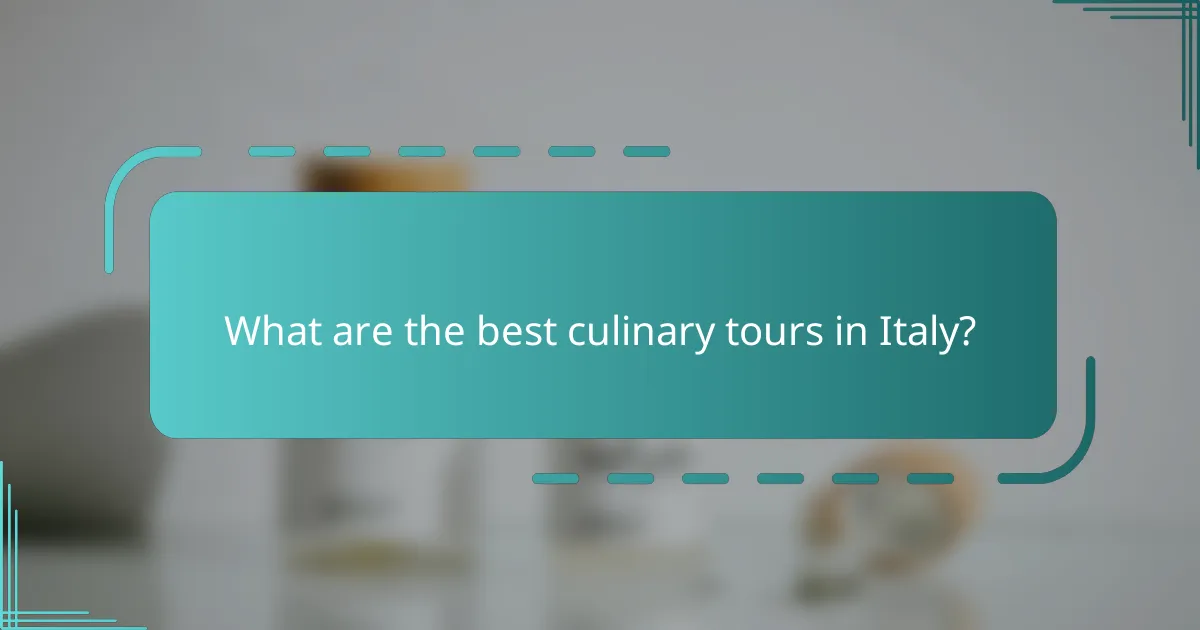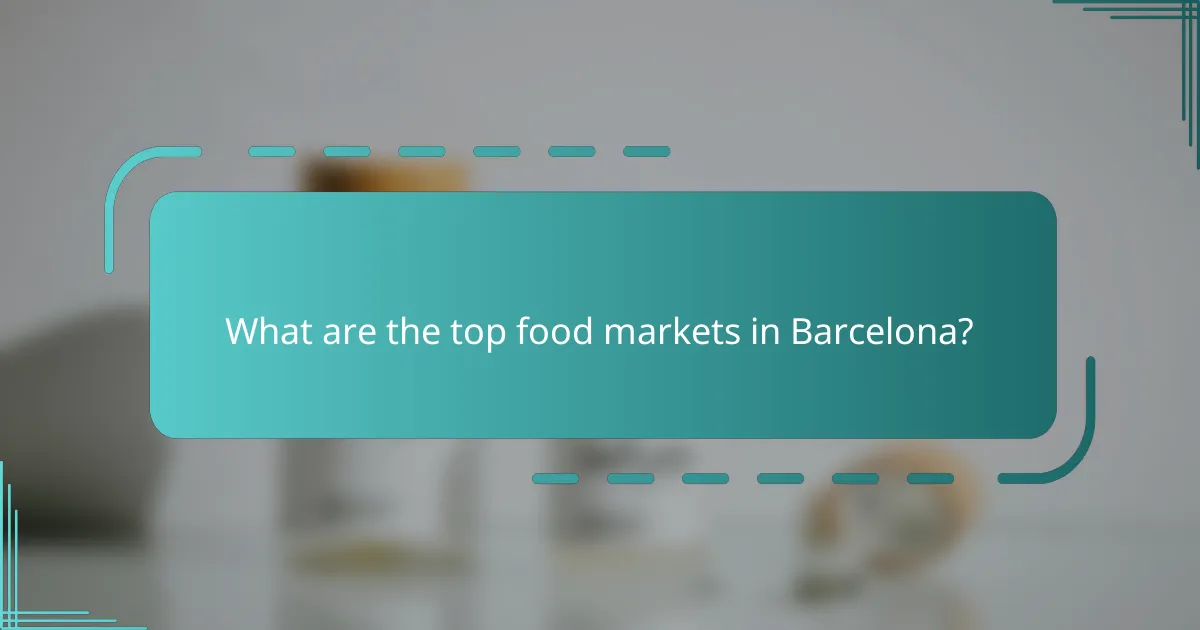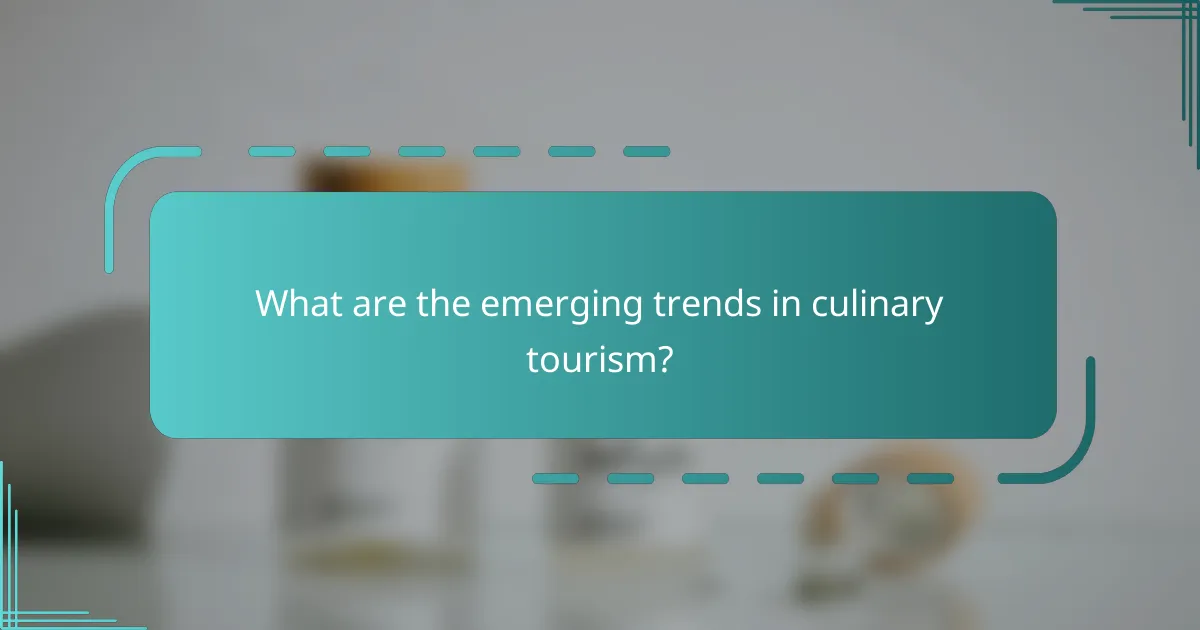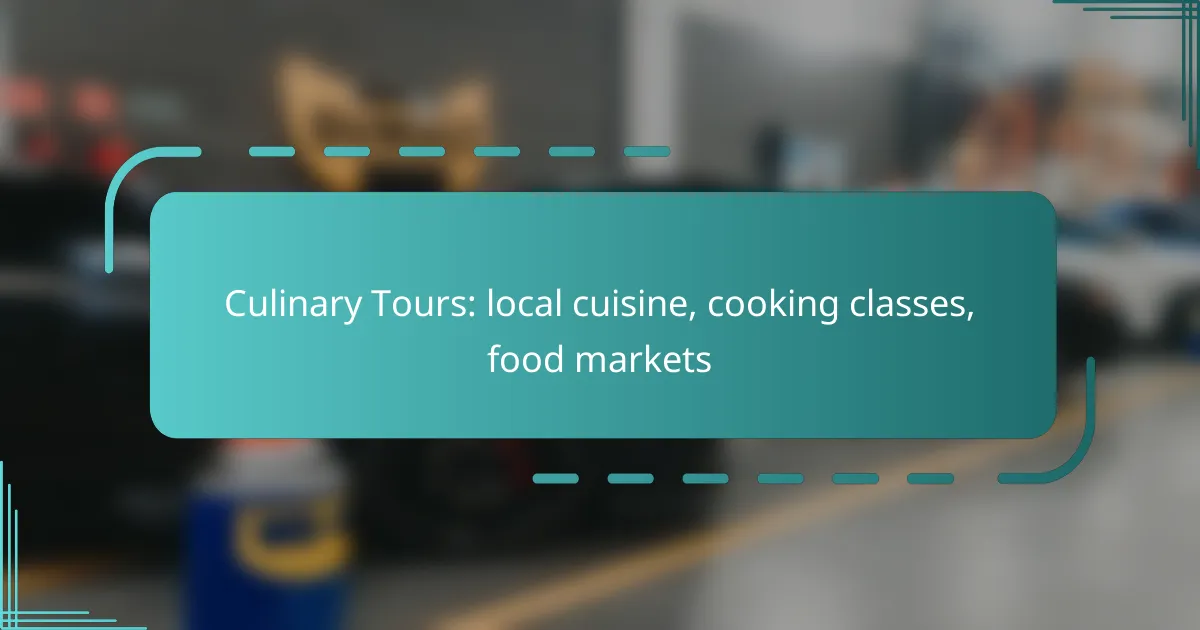Culinary tours provide an exciting opportunity to dive into local cuisine through hands-on cooking classes, vibrant food markets, and regional delicacies. Whether you’re exploring the rich flavors of Italy, mastering French cooking techniques in Paris, or discovering the bustling markets of Barcelona, these experiences offer a unique glimpse into the heart of each culture’s food heritage.

What are the best culinary tours in Italy?
The best culinary tours in Italy offer immersive experiences that highlight local cuisine, cooking classes, and food markets. These tours allow participants to explore regional flavors, learn cooking techniques, and discover the vibrant food culture unique to each area.
Gastronomic Tours in Tuscany
Gastronomic tours in Tuscany focus on the region’s rich culinary heritage, featuring traditional dishes and local ingredients. Participants often visit farms, olive oil producers, and cheese makers, gaining insight into the production processes behind iconic Tuscan foods.
Many tours include hands-on cooking classes where you can prepare classic meals like ribollita or pici pasta. Expect to enjoy tastings of local wines, such as Chianti, paired with your culinary creations.
Street Food Tours in Palermo
Street food tours in Palermo showcase the city’s vibrant food scene, highlighting its unique blend of Sicilian and Mediterranean flavors. Participants can sample a variety of street foods, including arancini, panelle, and cannoli, while exploring local markets and bustling neighborhoods.
These tours often include guided tastings at food stalls and markets, providing a chance to interact with local vendors. Be prepared to walk and immerse yourself in the lively atmosphere, as Palermo’s street food culture is best experienced on foot.
Wine and Food Pairing Tours in Piedmont
Wine and food pairing tours in Piedmont emphasize the region’s renowned wines, such as Barolo and Barbaresco, alongside local culinary delights. These tours typically include visits to vineyards, where participants can learn about winemaking and the significance of terroir.
During the tours, expect guided tastings that pair regional dishes with specific wines, enhancing the overall dining experience. Look for tours that offer a balance of vineyard visits and culinary experiences to fully appreciate Piedmont’s gastronomic offerings.

How to choose a cooking class in Paris?
Choosing a cooking class in Paris involves considering your skill level, the type of cuisine you want to learn, and the class format. Look for classes that offer hands-on experience and authentic local recipes to make the most of your culinary journey.
Hands-on Cooking Classes at Le Cordon Bleu
Le Cordon Bleu is renowned for its comprehensive culinary programs, offering hands-on cooking classes that cater to various skill levels. These classes typically focus on classic French techniques and dishes, allowing participants to learn from experienced chefs in a professional kitchen setting.
Classes can range from a few hours to multiple days, with prices generally starting in the low hundreds of euros. Be sure to check the schedule in advance, as popular classes can fill up quickly.
Market-to-Table Classes in Le Marais
Market-to-table classes in Le Marais provide a unique experience by combining a visit to local food markets with cooking. Participants often start by selecting fresh ingredients from nearby stalls, guided by a chef who shares insights on seasonal produce and local specialties.
These classes usually last half a day and are priced moderately, often around 100 to 150 euros. This format not only enhances your cooking skills but also deepens your understanding of Parisian culinary culture.

What are the top food markets in Barcelona?
Barcelona is home to several vibrant food markets that showcase the city’s rich culinary heritage. These markets offer a variety of fresh produce, local delicacies, and unique culinary experiences, making them essential stops for food lovers.
La Boqueria Market
La Boqueria Market, located just off Las Ramblas, is one of the most famous food markets in Barcelona. It features a wide array of stalls selling fresh fruits, vegetables, seafood, meats, and prepared foods, attracting both locals and tourists alike.
Visitors can enjoy a variety of tapas and local dishes at the market’s many eateries. Be sure to try some traditional Catalan specialties, such as jamón ibérico and fresh seafood paella, while soaking in the lively atmosphere.
Mercat de Sant Antoni
Mercat de Sant Antoni is another popular market, known for its stunning architecture and diverse offerings. Recently renovated, this market provides a mix of fresh produce, meats, and specialty foods, along with a section dedicated to second-hand books and clothing.
This market is less touristy than La Boqueria, making it a great place to experience local life. It’s advisable to visit on Sundays when the market hosts a vibrant food and flea market, perfect for sampling local delicacies and finding unique souvenirs.

What should I expect from a culinary tour experience?
A culinary tour experience typically immerses you in the local food culture, showcasing regional ingredients, cooking techniques, and traditional dishes. Expect to engage in tastings, hands-on cooking classes, and visits to vibrant food markets that highlight the area’s culinary heritage.
Local Ingredient Tastings
Local ingredient tastings allow you to sample fresh produce, meats, and spices unique to the region. These tastings often occur at markets or farms, where you can learn about the sourcing and significance of each ingredient. For example, in Italy, you might taste heirloom tomatoes or artisanal cheeses, while in Thailand, you could explore exotic fruits and herbs.
Consider participating in tastings that include a variety of items to fully appreciate the local flavors. Look for tours that feature seasonal ingredients, as these will provide the freshest and most vibrant tastes. Don’t hesitate to ask questions about the origins and uses of the ingredients to enhance your understanding.
Guided Cooking Sessions
Guided cooking sessions are hands-on experiences where you learn to prepare traditional dishes under the guidance of a local chef. These sessions typically include instruction on techniques, ingredient preparation, and cooking methods specific to the region. For instance, in Mexico, you might learn to make fresh tortillas and salsas, while in Japan, you could explore sushi-making.
When selecting a cooking class, consider the group size for a more personalized experience. Smaller classes often allow for more interaction with the instructor and better guidance. Be sure to check if the class includes a meal at the end, as enjoying the dishes you’ve prepared can be a rewarding conclusion to the session.

What are the benefits of culinary tours?
Culinary tours offer a unique opportunity to explore local cuisine while immersing oneself in the culture of a region. Participants gain firsthand experience with traditional cooking methods, local ingredients, and the vibrant food markets that define a destination’s culinary landscape.
Authentic Cultural Experiences
Engaging in culinary tours allows travelers to connect with local communities and their traditions. Participants often visit family-owned restaurants, local markets, and farms, gaining insights into the history and significance of various dishes.
For example, in Italy, a culinary tour might include a visit to a vineyard where participants learn about wine production alongside traditional pasta-making classes. This hands-on approach fosters a deeper appreciation for the culture and the people behind the cuisine.
Skill Development in Cooking
Culinary tours frequently include cooking classes that cater to various skill levels, from beginners to advanced cooks. Participants can learn new techniques, explore regional flavors, and even receive tips from professional chefs.
In a typical cooking class, you might learn to prepare local specialties such as paella in Spain or sushi in Japan. These experiences not only enhance cooking skills but also provide practical knowledge about ingredient selection and meal presentation.

How to prepare for a culinary tour?
Preparing for a culinary tour involves understanding the local cuisine and ensuring you have the right tools for cooking. This preparation enhances your experience and allows you to fully engage with the culinary culture of the region.
Research Local Cuisine
Understanding the local cuisine is crucial for a successful culinary tour. Investigate traditional dishes, ingredients, and cooking techniques specific to the area you will be visiting. This knowledge will help you appreciate the flavors and methods you encounter during your tour.
Look for regional specialties, which can vary significantly even within a country. For example, if traveling to Italy, familiarize yourself with the differences between Neapolitan and Roman pizza. Engaging with local food blogs or culinary guides can provide valuable insights.
Pack Essential Cooking Tools
Bringing the right cooking tools can enhance your culinary tour experience. Consider packing a few essential items like a chef’s knife, a small cutting board, and a reusable shopping bag for market visits. These tools can make cooking classes more enjoyable and efficient.
However, be mindful of airline regulations regarding carrying knives and other sharp objects. If you are traveling internationally, check the customs regulations for bringing food-related items into the country. In some cases, it may be more practical to purchase tools locally.

What are the emerging trends in culinary tourism?
Emerging trends in culinary tourism focus on unique, immersive experiences that highlight local cuisine, sustainability, and cultural authenticity. Travelers increasingly seek out cooking classes, food markets, and farm-to-table dining options that connect them with the local food scene.
Sustainable Food Practices
Sustainable food practices in culinary tourism emphasize environmentally friendly methods of sourcing and preparing food. This includes supporting local farmers, reducing food waste, and using seasonal ingredients, which not only enhances the dining experience but also benefits the local economy.
Travelers can engage in sustainable culinary experiences by participating in farm tours or cooking classes that highlight these practices. For instance, a cooking class in Italy might focus on using organic vegetables from nearby farms, while a market tour in Thailand could showcase local fish caught using traditional, sustainable methods.
When exploring sustainable food options, look for certifications or labels that indicate eco-friendly practices, such as organic or fair trade. Additionally, consider dining at restaurants that prioritize local sourcing and have transparent supply chains to ensure your culinary experience supports sustainable initiatives.
